It’s that time again!
 This week, we’re looking at Runaway City.
This week, we’re looking at Runaway City.

Runaway City, or Meisou Toshi, was made in 1995, but wasn’t translated into English until 1998, two years after Seasons of the Sakura was both originally released in Japanese AND translated into English.
In retrospect, it’s weird that I didn’t start out with Runaway City. It’s the oldest of the three Jast games in the collection, and its age reaaaaally shows. Ultimately, it’s just that I wanted to play Three Sisters’ Story again more.
Before we go on, I feel I have to address a little more about how this re-release/update is presented. The collection on the disc consists of Runaway City, Three Sisters’ Story, and Seasons of the Sakura. Now, the way collections like these work is you have a main title and choose which game you want to play. What the JAST USA Collection does is similar, but different in a weird-ass way. The main menu is basically ALL THREE of the games’ main menus ALL AT ONCE… BUT WORSE!
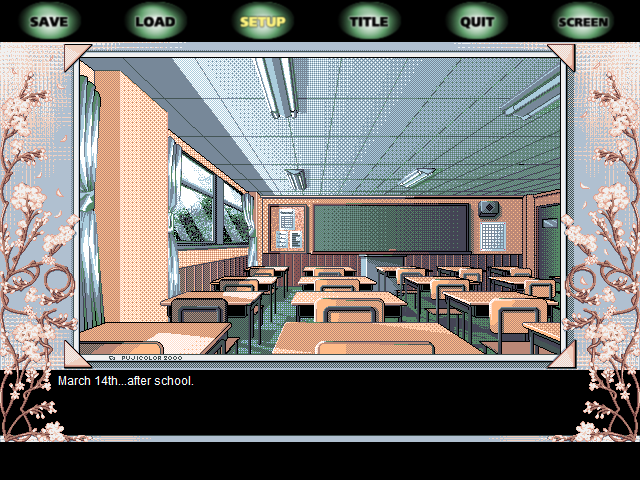
When you hover over the picture of a game’s title screen, you get the choices of “New Game,” “Load Game,” and “CG Room.” Should you pick “New Game,” the program crashes unless you have the CD actually in the tray. Now, assuming you have the CD actually loaded up, then selecting “New Game” does just that: starts the program up and starts a new game. This means that at no point do you ever get to see the main title as it was meant to be seen. No big deal, right? I mean, you can see what the title screen looks like, and all you’re missing out is the title music. Well, when it comes to Runaway City, that’s a problem. You see, Runaway City actually has a short opening cinematic and some damn good title music. I really would like to share it, but I just can’t get the original DOS version of the game running on Kiria (that’s my computer’s name for those who don’t know). Since I can’t show it to you, I’ll describe it: we see sepia pictures of a seed sprouting in a field, then it grows into a large tree. The tree is surrounded by buildings, and what we see last is the title screen, showing the city the game takes place in. It has no apparent meaning behind it until waaaaaay late into the game.
Anyway, I already talked about how bad the “updated” art is (it’s really just a blur filter), and it’s never been so immediately apparent as it is upon starting a new game of Runaway City:
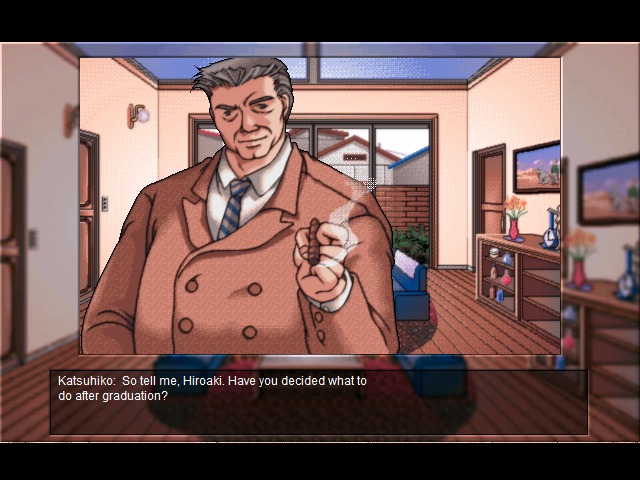
Anyway, let’s start talking about the actual content of the game. You play Hiroaki, a high school student about to graduate. His dad is pestering him about what he plans to do about his future, and Hiroaki proves to be a frustrating loser of a protagonist in this respect. He literally has no fucking clue what to do with his life and has no intentions of taking a cushy job at his dad’s video game company. Of course, the protagonist is only a loser in that respect. It’s actually a plot point that he seems to have a supernatural amount of luck. And, well… he’s a protagonist in a hentai game. C’mon.
Now, if you thought the first day of Three Sisters’ Story was bad… hoo boy. EVERY day of Runaway City is godawful. The first day starts with listening to Hiroaki’s dad’s lecturing. Then he goes out to the city and you’re given two choices: go to the arcade or go to the bookstore. Ultimately, it doesn’t matter which you choose; you’ll end up in the main street and do ANYTHING else. You NEVER go to the bookstore, and you save the arcade for last. Speaking of the arcade… Rin.

Yeah, Rin’s pretty much my favorite girl in this game. She’s the tomboyish arcade expert, and that’s a set we rarely ever see in… well, anything. She also has an amusing hentai scene that left a lasting impression on me. She’s literally the only character I remembered before I even started playing this disc. It’s a shame because out of all the girls Hiroaki encounters, Rin probably has the least relevance out of all of them.
Anyway, nearly every day is the same: you head out into the street, then you hit EVERY SINGLE PLACE until you’re out of options, then you get railroaded into the next hentai scene. As far as I can tell, only one hentai scene in the entire game is optional (and I’m not counting the bad ending scene, since you WILL get it). The game is just Hiroaki wandering around aimlessly and randomly having sex with a girl he manages to help. It’s kinda like if the entire game were the sidequest of Three Sisters’ Story. Actually, Runaway City came first, so that’s probably why TSS had that sidequest awkwardly shoved in.
For the longest time, none of the choices you make really matter, if you’re even given a choice at all. If this were a visual novel, it wouldn’t be much of a problem. However, this is more adventure game than visual novel, and that means a LOT more meaningless option clicking. You have to LOOK, ASK, TALK, and GO to everything that’s presented to progress. Until the last section of the game, all that mechanic serves to do is frustrate you.
Almost none of the characters are at all interesting. Rin’s pretty much the only one that stands out, and even then, it’s not necessarily due to the strength of her character. Every girl pretty much lives and dies on how appealing their design is. You don’t really get to know anyone long enough to care about them, so really all you’re feeling towards them is how badly you want to see them undressed based on how they look. And to be fair… most of these girls look really, REALLY good.
While I’m on the subject of the girls, one of the girls you get to have sex with is… fairly unique. It’s probably the weirdest piece of trivia you’ll learn here. Yumirin Kroda is the star of a porno video that Hiroaki can choose to watch before going to sleep. Unexpectedly, he gets to actually do her. But that’s not the interesting part. This is:
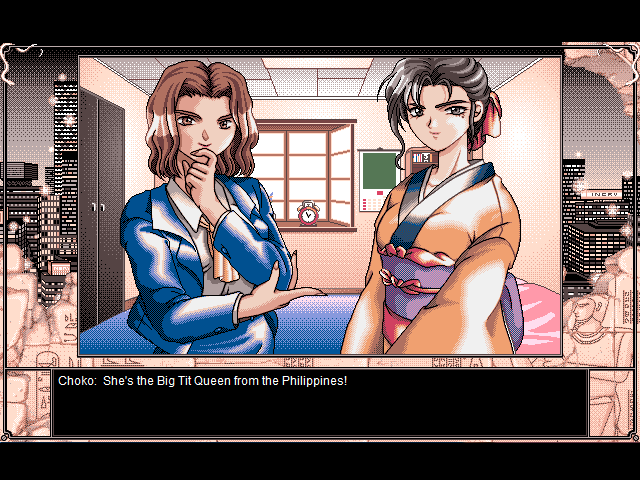
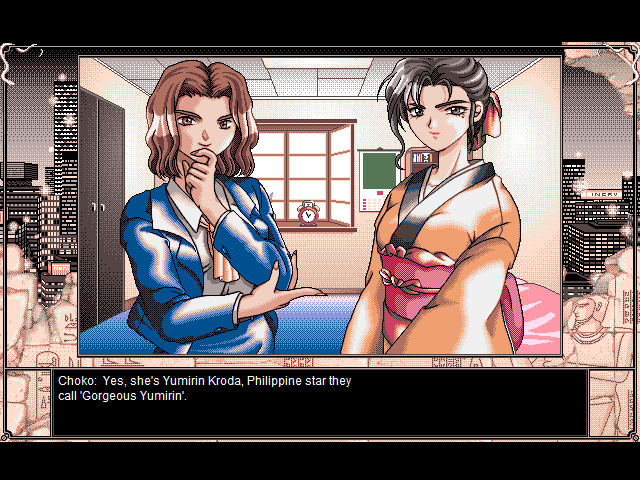
Again, Runaway City was made in 1995. That’s both four years before Front Mission 3 and three years before the more obscure Sampaguita (which also has some impressive names behind it and is in severe need of a fan translation). What this means is that Runaway City may just be the earliest known video game to have a Filipino character, and that character is the depressingly average-looking Yumirin Kroda. Please, somebody, find a video game with a Filipino character made before December 1995. I just don’t know if I can stomach Yumirin Kroda being the first Filipino video game character. Sampaguita’s Maria Santos REALLY deserved that title.
So anyway, let’s talk about the twist. A little over halfway through the game and… let’s say six sex scenes with different girls later, Hiroaki notices that the latest girl he slept with had an unsettlingly sudden and dramatic change of demeanor. She was normally kinda grating to him, but the night after he has sex with her, she’s more demure (the way he likes it). He starts to wonder if there’s more to his “luck” than just that, and if he really has the “power” to change girls’ personalities. He talks with some mentor figures who seem to convince him that sometimes girls just change as a process of maturing, but then another encounter (long story short: he rapes a piece of scum author and inadvertently turns her into a masochist) freaks him out, and he shuts himself in his room so he won’t “change” any girls ever again.
Honestly, if you really think about it, it’s a clever deconstruction of the hentai game long before any other game ever thought to deconstruct it well. In a vast majority of hentai games, you control a protagonist who seems to be the only person in the world capable of solving the problems of the girls he encounters. Runaway City shows us that A) any guy this happens to has to be the luckiest man in the world, and B) there’s seriously something wrong about that premise. It’s unfortunate that the cleverness of this deconstruction is vastly overshadowed by how crappy the mechanics of the game, the characters, and the overall plot are.
Well, it turns out that Hiroaki’s spirit is linked to an ancient tree enshrined underground somewhere. This tree is known for its amazing fortunes. Also, it talks in all-caps.
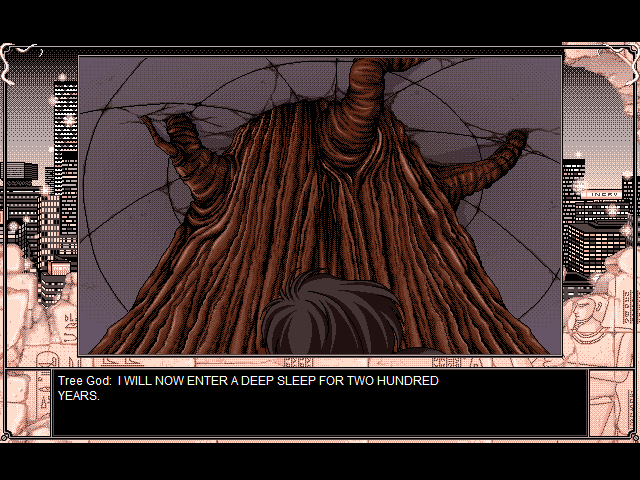
Hiroaki wants a way to rid himself of his power, and the tree responds by saying there is a way… that might kill him. Hiroaki says go for it. The tree… kinda goes fuck that and instead shows him a series of visions. The first vision basically shows him the kind of immoral blackmailing slut the first girl Hiroaki “helps” would be if he didn’t have his power. But here’s where it gets confusing: up to now, the only way to progress in the game is to exhaust all your options. But here, if you choose to “LOOK AWAY” from the scene one too many times without “THINK”ing first, the vision ends and Hiroaki is left with his power despite wanting to get rid of it. It’s not like he chose to keep it; you just get a bad ending for not thinking about the right thing before progressing too far.
So yeah, this is the beginning of the final section of the game. It ends with puzzle built around arbitrary decisions.
So if you think about the first vision successfully, you’re given a decision about whether or not people have been improved because of his power.
Next, Hiroaki sees how his power can be abused for both good and bad. In the final vision, he sees how it’s possible to rule the world with his power and just how far he can be corrupted by it, and the only way to break out of the final vision is to pick every choice to do good and NOT rape people (y’know, before he’s forced to rape people just to progress the story).
Ultimately, the visions are pointless as fuck because HE DOESN’T FUCKING WANT THE POWER. The whole final puzzle really adds nothing to the story other than shoving in a bunch of last-minute sex scenes. It’s really just one last frustrating mechanic that feels like a massive middle finger to anyone who made it that far into the game. And it’s not even the game’s final middle finger. That final middle finger? The good ending forces you into a relationship with Yuki, redhead who also happens to be the most tsundere girl in the game. She’s also the girl with the third-least amount of backstory and character development in a game filled with girls with trash for backstory and near-zero character development. It makes me wonder why “tsundere” only became a popular term so recently when anime has a long, long, LOOOOOOOONG history of making tsunderes the only archetype that matters when it comes to winning the affections of the main character. Hell, Urusei Yatsura started out with the main love interest being a tsundere, then evolved into A DIFFERENT TSUNDERE being the main love interest. Buuuuut I’m digressing.
Overall, Runaway City is a game with a couple of ambitious ideas, put together by a team that lacks the talent to pull it off. The story occasionally shows flashes of brilliance, but it can’t carry its own characters. The overall mechanics of the game make it pointlessly frustrating. The music… oh gawd, the music… A few of tracks are decent and some of them are even appropriately haunting, but it can be just awful, especially with how inappropriate they usually are during the sex scenes, sometimes changing from romantic to silly and upbeat completely arbitrarily. But the worst is the track that plays when you’re wrapping up the day. It’s literally a five second track that doesn’t even have the common courtesy to loop; it just stops and replays awkwardly over and over again. Runaway City… The only way that title makes sense is if it’s actually instructions for you to run away from it.
Well, next week is the last of the JAST USA collection: Seasons of the Sakura. Now that’s something I’m looking forward to, along with the Milky collection.
